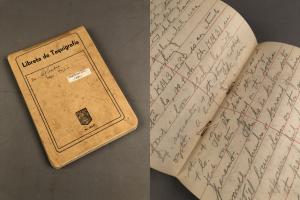The Smithsonian’s Field Book Project is a continuous fount of work for both our digitization crew here at the Archives and for me as the conservator in charge of the project’s physical needs. Over the past several weeks I have worked on a variety of field books with different structures and treatment requirements, and will share a few of the most common features I’ve seen in the Axel A. Olsson papers.
Journals came and still do come in a variety of shapes, sizes, and bindings; wire-bound and pamphlet-style stapled bindings are among the most common in the Olsson papers, alongside more traditional-looking hardbound books. Many of the wire-bound journals had already had their wires removed, some by the simple expedient of having the pages ripped or cut away from the wire spiral. Since it’s not feasible or desirable to replace the wire (especially if the holes have been cut away), these required an enclosure within the folders where they lived. These are usually four-flap enclosures, made from two pieces of 20-point folder stock which are held together with double-sided adhesive tape, with flaps at the top, bottom, and sides to protect the items from all directions. A simple slit and tab are used to hold the four-flap closed. The example shown also had a buffered paper four-flap that nestles inside the folder stock one, to protect the delicate paper of the journal.
Stapled notebooks intended for stenographers are also common. The staples have frequently rusted a good deal and the rust will catalyze the paper’s deterioration, so we always remove staples in this condition. Some of the books that have more delicate paper were left disbound and placed in four-flaps as described with the wire-bound notebooks; those with more robust paper received a new structure by passing a length of linen thread through the holes made by the staples, and tied with simple knots to hold the book in one piece. Some of the books, as shown in this example, have gummed paper tape that covered the staples from the exterior. This was frequently detached, which made it easier to remove the staples, replace them with thread, and reattach the tape over the new binding.
Finally, some of the journals contained photographs held in place with thin strips of gummed paper tape. Many of the field books are made of poor-quality paper that can cause adverse reactions in the photographs, which are complex chemical objects. As a result, we added interleaving cut to size from a photo-safe paper, and adhered them with small pieces of heat-activated acrylic adhesive. This preserves the original arrangement of the photographs alongside the notes they supplement while preserving the images the best we can.
The field books are endless sources of fascinating content and conservation challenges. Our Senior Conservator, Nora Lockshin, and I will be sharing more about the materiality of the Smithsonian field books at next year’s Annual Meeting of the American Institute for Conservation in Houston, Texas. In addition to describing the materials that make up the field books and the materials sometimes found within them, we will discuss more about how their make-up impacts how we choose to treat them.
Related Resources
- “The Field Book Project: Uncovering Hidden Gems at the Smithsonian,” The Bigger PIcture Blog
Produced by the Smithsonian Institution Archives. For copyright questions, please see the Terms of Use.

Leave a Comment